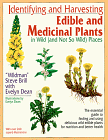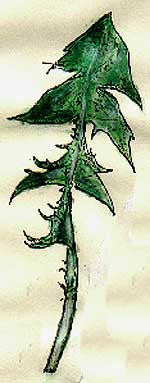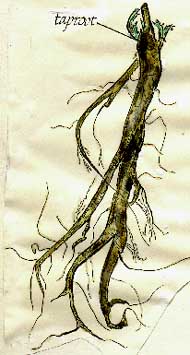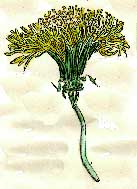|
|
 Identifying and Harvesting Edible and Medicinal Plants in
Wild (and Not So Wild) Places Identifying and Harvesting Edible and Medicinal Plants in
Wild (and Not So Wild) PlacesBy: "Wildman"
Steve Brill
Book Excerpt: COMMON DANDELION
(Taraxacum officinale)
The dandelion is a perennial, herbaceous plant with long,
lance-shaped leaves. They’re so deeply toothed, they gave the plant its name in Old
French: Dent-de-lion means lion’s tooth in Old French. The leaves are 3-12"
long, and 1/2 - 2-1/2" wide, always growing in a basal rosette. The rosette’s
immature, tightly wrapped leaf bases just above the top of the root form a tight
"crown".
Dandelion’s well-known yellow, composite flowers are 1-2"
wide. They grow individually on hollow flowerstalks 2-18" tall. Each flowerhead
consists of hundreds of tiny ray flowers. Unlike other composites, there are no disk
flowers. Reflexed bracts grow under each flower. The flowerhead can change into the
familiar, white, globular seedhead overnight. Each seed has a tiny parachute, to spread
far and wide in the wind.
The thick, brittle, beige, branching taproot grows up to 10"
long. All parts of this plant exude a white milky sap when broken.
There are no poisonous look-alikes. Other very similar Taraxacum
species, as well as chicory and wild lettuce (see page ØØ) only resemble dandelions in
the early spring. All these edibles also exude a white milky sap when injured, but chicory
and wild lettuce leaves have some hair, at least on the underside of the midrib, while
Taraxacum leaves are bald. Unlike the other genera, Taraxacum stays in a basal rosette. It
never grows a tall, central, stalk bearing flowers and leaves.
Dandelions are especially well-adapted to a modern world of
"disturbed habitats," such as lawns and sunny, open places. They were even
introduced into the Midwest from Europe to provide food for the imported honeybees in
early spring. They now grow virtually worldwide. Dandelions spread further, are more
difficult to exterminate, and grow under more adverse circumstances most competitors.
Most gardeners detest them, but the more you try to weed them up,
the faster they grow. The taproot is deep, twisted, and brittle. Unless you remove it
completely, it will regenerate. If you break off more pieces than you unearth, the
dandelion wins. "What’s a dandelion digger for?" a dandelion asked.
"It’s a human invention to help us reproduce," another dandelion replied.
Collect dandelion leaves in early spring, when they’re the
tastiest, before the flowers appear. Harvest again in late fall. After a frost, their
protective bitterness disappears. Dandelions growing in rich, moist soil, with the
broadest leaves and largest roots, are the best. Select the youngest individuals, and
avoid all plants with flowers. Some people eat the greens from spring to fall, when
they’re very bitter. Others boil out the summer bitterness (and water-soluble
vitamins) out in two changes of water. It’s all a matter of preference.
Dandelion greens are wonderful in salads, sautéed or steamed. They
taste like chicory and endive, with an intense heartiness overlying a bitter tinge. People
today shun bitter flavors—they’re so conditioned by overly sweet or salty
processed food.
 Dandelion Leaf Dandelion Leaf
pen and ink,
watercolor pencils
"Wildman" |

Dandelion Taproot
pen and ink, watercolor
pencils
"Wildman" |

Dandelion Seed
Head
pen and ink,
watercolor pencils
"Wildman |

Dandelion Flower
pen and ink,
watercolor pencils
"Wildman" |

Dandelion
Seed
pen and ink,
watercolor
pencils
"Wildman" |
But in earlier times, we distinguished between good and bad bitterness. Mixed with other
flavors, as in a salad, dandelions improve the flavor.
I also love sautéing them for about 20 minutes with onions and
garlic in olive oil, adding a little homemade wine before they’re done. If
you’re not used to the slight bitterness, cook them with sweet vegetables, especially
sliced carrots and parsnips. Boiling dandelions in one or more changes of water makes them
milder—a good introduction if you’re new to natural foods. Early spring is also
the time for the crown—great sautéed, pickled, or in cooked vegetable dishes.
You can also eat dandelion flowers, or use them to make wine.
Collect them in a sunny meadow, just before mid-spring, when the most flowers bloom. Some
continue to flower right into the fall. Use only the flower’s yellow parts. The green
sepals at the flower’s base are bitter. The flowers add color, texture, and an
unusual bittersweet flavor to salads. You can also sauté them, dip them in batter and fry
them into fritters, or steam them with other vegetables. They have a meaty texture that
contrasts with other lighter vegetables in a stir-fry dish or a casserole. A Japanese
friend makes exceptionally delicious traditional dandelion flower pickles, using vinegar
and spices.
The taproot is edible all year, but is best from late fall to early
spring. Use it as a cooked vegetable, especially in soups. Although not as tasty as many
other wild root vegetables, it’s not bad. I remember finding large dandelions with
huge roots growing on the bottom of a grassy hillside. They were only mildly bitter, so I
threw them into a potato stock. With the added scallions, tofu, ginger, carrots and miso,
this became an excellent Japanese miso soup.
Pre-boiling and changing the water, or long, slow simmering mellows
this root. Sweet vegetables best complement dandelion roots. Sautéing the roots in olive
oil also improves them, creating a robust flavor. A little Tamari soy sauce and onions
complete this unusual vegetable side dish.
The leaves are more nutritious than anything you can buy.
They’re higher in beta-carotene than carrots. The iron and calcium content is
phenomenal, greater than spinach. You also get vitamins B-1, B-2, B-5, B-6, B-12, C, E, P,
and D, biotin, inositol, potassium, phosphorus, magnesium, and zinc by using a tasty, free
vegetable that grows on virtually every lawn. The root contains the sugar inulin, plus
many medicinal substances.
Dandelion root is one of the safest and most popular herbal
remedies. The specific name, officinale, means that it’s used medicinally. The
decoction is a traditional tonic. It’s supposed to strengthen the entire body,
especially the liver and gallbladder, where it promotes the flow of bile, reduces
inflammation of the bile duct, and helps get rid of gall stones. This is due to its
taraxacin. It’s good for chronic hepatitis, it reduces liver swelling and jaundice,
and it helps indigestion caused by insufficient bile. Don’t use it with irritable
stomach or bowel, or if you have an acute inflammation.
The modern French name for this plant is pissenlit (lit means bed)
because the root and leaf tea act on the kidneys as a gentle diuretic, improving the way
they cleanse the blood and recycle nutrients. Unlike pharmaceuticals diuretics, this
doesn’t leach potassium, a vital mineral, from the body. Improved general health and
clear skin result from improved kidney function. One man I spoke to even claims he avoided
surgery for urinary stones by using dandelion root tea alone.
Dandelions are also good for the bladder, spleen, pancreas, stomach
and intestines. It’s recommended for stressed-out, internally sluggish, and sedentary
people. Anyone who's a victim of excessive fat, white flour, and concentrated sweeteners
could benefit from a daily cup of dandelion tea.
Dandelion root’s inulin is a sugar that doesn’t elicit the
rapid production of insulin, as refined sugars do. It helps mature-onset diabetes, and I
used it as part of a holistic regime for hypoglycemia. (low blood sugar).
Dandelion leaf infusion also good at dinnertime. Its bitter elements
encourage the production of proper levels of hydrochloric acid and digestive enzymes. All
the digestive glands and organs respond to this herb's stimulation. Even after the plant
gets bitter, a strong infusion, is rich in vitamins and minerals, and helps people who are
run-down. Even at its most bitter (Taraxacum come from Arabic and Persian, meaning
"bitter herb"), it never becomes intolerably so, like golden seal and gentian.
The leaf's white, milky sap removes warts, moles, pimples, calluses,
and sores, and soothes bee stings and blisters.
Unlike most other seeds, dandelions’ can germinate without long
periods of dormancy. To further increase reproductive efficiency, the plant has given up
sex: The seeds can develop without cross-fertilization, so a flower can fertilize itself.
This lets it foil the gardener by dispersing seeds as early as the day after the flower
opens.
Sexual reproduction leads to greater genetic diversity. This may be
important for adapting to predators and parasites, which also change their genetic makeup
to increase effectiveness. But the survival criteria vary from niche to niche. Moral: When
maximum reproductive speed becomes the key to survival, don’t get caught by the
evolution's lawnmower with your plants down!
A funny thing happened to me when I was collecting dandelions one
day in Central Park. Two tour participants were undercover city Park Rangers. They had
used marked bills, surveillance cameras, and walkie-talkies to infiltrate the group. When
I ate a dandelion, the entire Parks Enforcement Patrol converged on my group, and I was
handcuffed and arrested for removing vegetation from the park. But after I was
fingerprinted, they couldn't hold me. I had eaten all the evidence.
I called every newspaper, TV station, and wire service The next day,
when I went to get the paper, five cops stopped me. They wanted my autograph. I was on
page one of the Chicago Sun-Times, in newspapers and on the radio around the country. WCBS
Evening News with Dan Rather covered the story, national and local talk show appearances
followed.
When I had to appear court, I served passersby and reporters
"Wildman’s Five-Boro Salad," complete with dandelions, on the steps of the
Manhattan Criminal Court, and the press ate it up once more.
A month later, the city dropped the charges, and hired me as a
naturalist, to lead tours teaching people to eat dandelions and other wild foods. I worked
for the New York City Parks Department for four years, leaving and resuming freelance
activities after a new anti-environmental administration took office.
_______________________________________________
Click here to visit Steve's Web Site |
